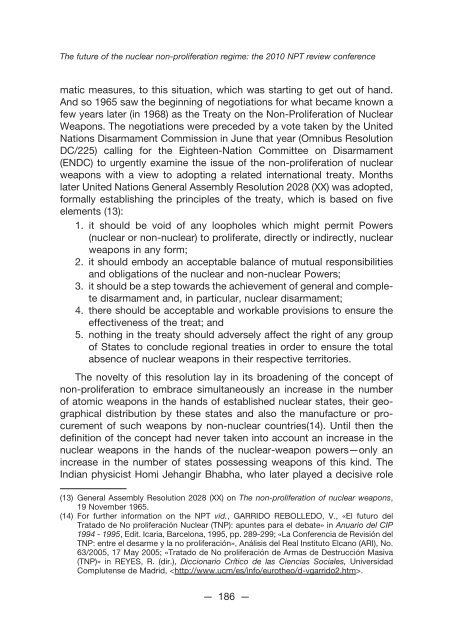Strategic Panorama 2009 - 2010 - IEEE
Strategic Panorama 2009 - 2010 - IEEE
Strategic Panorama 2009 - 2010 - IEEE
You also want an ePaper? Increase the reach of your titles
YUMPU automatically turns print PDFs into web optimized ePapers that Google loves.
The future of the nuclear non-proliferation regime: the <strong>2010</strong> NPT review conference<br />
matic measures, to this situation, which was starting to get out of hand.<br />
And so 1965 saw the beginning of negotiations for what became known a<br />
few years later (in 1968) as the Treaty on the Non-Proliferation of Nuclear<br />
Weapons. The negotiations were preceded by a vote taken by the United<br />
Nations Disarmament Commission in June that year (Omnibus Resolution<br />
DC/225) calling for the Eighteen-Nation Committee on Disarmament<br />
(ENDC) to urgently examine the issue of the non-proliferation of nuclear<br />
weapons with a view to adopting a related international treaty. Months<br />
later United Nations General Assembly Resolution 2028 (XX) was adopted,<br />
formally establishing the principles of the treaty, which is based on five<br />
elements (13):<br />
1. it should be void of any loopholes which might permit Powers<br />
(nuclear or non-nuclear) to proliferate, directly or indirectly, nuclear<br />
weapons in any form;<br />
2. it should embody an acceptable balance of mutual responsibilities<br />
and obligations of the nuclear and non-nuclear Powers;<br />
3. it should be a step towards the achievement of general and complete<br />
disarmament and, in particular, nuclear disarmament;<br />
4. there should be acceptable and workable provisions to ensure the<br />
effectiveness of the treat; and<br />
5. nothing in the treaty should adversely affect the right of any group<br />
of States to conclude regional treaties in order to ensure the total<br />
absence of nuclear weapons in their respective territories.<br />
The novelty of this resolution lay in its broadening of the concept of<br />
non-proliferation to embrace simultaneously an increase in the number<br />
of atomic weapons in the hands of established nuclear states, their geographical<br />
distribution by these states and also the manufacture or procurement<br />
of such weapons by non-nuclear countries(14). Until then the<br />
definition of the concept had never taken into account an increase in the<br />
nuclear weapons in the hands of the nuclear-weapon powers—only an<br />
increase in the number of states possessing weapons of this kind. The<br />
Indian physicist Homi Jehangir Bhabha, who later played a decisive role<br />
(13) General Assembly Resolution 2028 (XX) on The non-proliferation of nuclear weapons,<br />
19 November 1965.<br />
(14) For further information on the NPT vid., GARRIDO REBOLLEDO, V., «El futuro del<br />
Tratado de No proliferación Nuclear (TNP): apuntes para el debate» in Anuario del CIP<br />
1994 - 1995, Edit. Icaria, Barcelona, 1995, pp. 289-299; «La Conferencia de Revisión del<br />
TNP: entre el desarme y la no proliferación», Análisis del Real Instituto Elcano (ARI), No.<br />
63/2005, 17 May 2005; «Tratado de No proliferación de Armas de Destrucción Masiva<br />
(TNP)» in REYES, R. (dir.), Diccionario Crítico de las Ciencias Sociales, Universidad<br />
Complutense de Madrid, .<br />
— 186 —

















